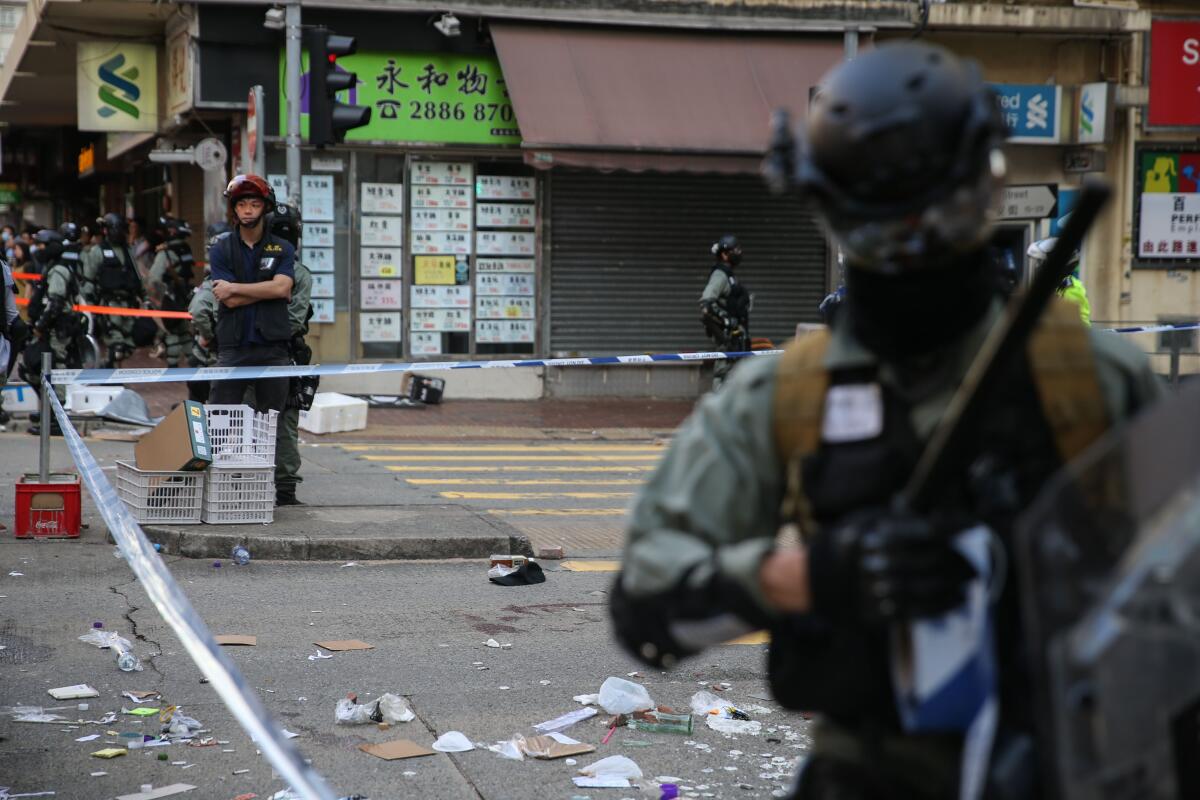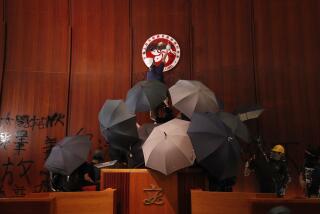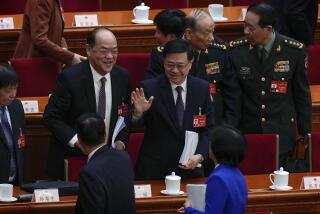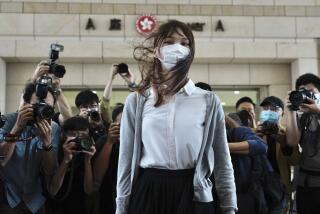Man set on fire after police shoot protester in Hong Kong

It isn’t the sort of violence normally seen in Hong Kong: A middle-aged man arguing with protesters is doused with “a flammable liquid” and set on fire, as a smartphone camera records it all, in a hard-to-watch video that unsurprisingly goes viral.
The man, badly burned but still alive, is rushed to a hospital emergency room, where he now fights for his life in an intensive care unit. He joins another person badly wounded Monday in Hong Kong — a young protester who was shot at close-range by a police officer — in one of the most violent days of protests seen in the Chinese territory. The young man is also in intensive care.
The incidents mark a new height of violence in a city already roiled by five months of relentless protests. What began as single-issue marches over an unwanted bill allowing extradition to China — now withdrawn — has become a widespread and increasingly violent movement focusing on Beijing’s control of the Hong Kong government, accountability for police brutality and a demand for democratic reforms.
Neither protesters nor the government is showing any sign of compromise.
Monday’s clashes erupted with police shooting the 21-year-old protester with live ammunition early in the morning. In a video widely circulated on social media, the protester, who appears to be unarmed, walks toward a police officer who has just tackled another demonstrator in a traffic intersection in Sai Wan Ho.
The young man reaches an arm toward the officer, who shoots him in the abdomen. He crumples to the ground. Photos show the shot protester, surnamed Chow, lying listless, though still breathing, as a riot officer rolls him over from a pool of his own blood.
An angry crowd hurled plastic crates at police before an ambulance arrived and took the injured protester away. Medical sources said he was moved to an intensive care unit after an operation on his ruptured liver and kidney.
Andrew Cheng Kar-foo, a lawyer and former lawmaker who was contacted by Chow’s parents, told local media that Chow had been “just walking past” the site on his way to a Lennon wall — a display where protesters cover a wall with Post-its bearing pro-democracy/anti-government messages — when he was shot.
Hours later, a middle-aged man was set on fire while arguing with protesters in the New Territories suburb of Ma On Shan.
Videos circulating on social media and confirmed by police showed a man in a green shirt arguing with a small crowd, blood already trickling down his face from an unknown cause. They curse at each other, the man accusing the crowd of being “not Chinese.”
They yell back that he should return to the Greater Bay area — a reference to a tech and business region in southern China into which Beijing wants to integrate Hong Kong. One person shouts at the man not to hit others.
Then someone lunges forward, pours a flammable liquid over the man and lights him on fire.
Flames spread over his body as bystanders scream and run.
Local media later identified the man as Leung Chi-cheung, a 57-year-old construction worker and father of two daughters who lives in Ma On Shan.
Police said Leung was undergoing treatment for second-degree burns on nearly 30% of his body, mainly his chest and arms. They classified the case as attempted murder.
Hong Kong Chief Executive Carrie Lam condemned protests at a news briefing Monday, telling citizens to stay away from them. She called demonstrators the “enemy of the people” and said they would “never win.”
“If there is still any wishful thinking,” Lam said, “that [through] escalating violence the Hong Kong SAR government will yield to pressure to satisfy the so-called political demands, I’m making this statement clear and loud here: That will not happen.”
More than 3,000 protesters have been arrested, at least a third of them students. Police have arrested 266 people since last Monday, ranging from 11 to 74 years old.
Since the Hong Kong government invoked an emergency law to ban masks at public assemblies in October, the number of protesters on the streets has decreased — but their intensity has sharpened.
Early in the morning, demonstrators blocked major arteries and disrupted train service during a planned citywide strike. Debris was reportedly used to block one rail line and a fire was set in one train car.
Clashes among police, protesters and residents soon broke out across the city after the shooting. At least six universities canceled classes as enraged students set subway stations on fire, threw gasoline bombs and built barricades against police firing tear gas and projectiles on campuses.
In Kwai Fong, a suburban town in the northern New Territories, a police officer chased and rammed into protesters on a motorcycle, zigzagging into them as they ran.
At lunchtime, hundreds of protesters, many in business wear, faced off with police in Hong Kong’s central financial district.
“Murderers!” they chanted.
Police fired several rounds of tear gas, chasing protesters with batons and pepper spray as mask-less office workers fled into nearby shopping malls, bent over coughing into their collared shirts.
John, a 25-year-old wearing office attire and a surgical mask, said he’d been on his way to work when he heard about the shooting Monday morning. Like other protesters, he asked not to disclose his full name for protection from authorities.
“How many students have to get shot before we do something?” he said. “There was no way I could go into work after this happened again. The police don’t see us as human anymore.”
The clashes came a day after police made dozens of surprise arrests Sunday at shopping malls using undercover personnel.
Anger over the police force and its tactics has been rising since the death Friday of Alex Chow Tsz-lok, a 22-year-old student who died of injuries sustained from falling from the third floor of a parking garage. It’s unclear what caused his fall, but demonstrators widely believed he was fleeing police firing tear gas.
Two young demonstrators were also shot by police, on Oct. 1 and 4. Both survived but were arrested and charged with rioting, an offense punishable by up to 10 years in jail.
At a news briefing Monday afternoon, a police spokesman defended the officer who shot the 21-year-old, saying he had done so because the protester was reaching for his pistol.
He played multiple videos of the man being set on fire and condemned “all acts of violence.”
“Continuing this rampage is a lose-lose situation for Hong Kong,” he said. “Everyone is a loser.”
The viral video of the man set on fire sparked immediate discussion on LIHKG, a popular online forum used by young protesters to discuss tactics and organize demonstrations.
Most did not condemn the attack, pointing to police and pro-police groups’ violence as justification. A widely liked post urged whoever was responsible for the fire to quickly flee Hong Kong.
“Have you forgotten everything the blue ribbons did to us?” wrote one user, referring to the nickname for police supporters. “Ears bitten off, bellies and throat cut, people thrown off bridges.”
On the streets, mostly young protesters continued to clash with police into the night. One woman in her 20s, Lau, wore black shorts, a T-shirt and a gray mask as she marched at the back of a protest group. She worried that others would label her “divisive” if she criticized protester vigilantism.
“I’m not opposed to violence — I think it’s necessary sometimes,” she said, “like in self-defense or to subdue an attacker. But to attack someone based on what they say? That’s really not OK.”
But Lau remembered reading in online chats after a previous street attack that anyone who tried to stop protesters from vigilante justice would also be considered an “enemy.”
Since reading that, she’d decided not to intervene if she ever saw a similar situation, despite her unease.
“I still believe in the main cause, and I want our movement to still be as noble as we make it out to be,” she said. At the same time, she added, “it’s hard to keep telling people we’re the good guys when they see things like this happen.”
Times staff writer Pierson and special correspondent Ho Kilpatrick reported from Hong Kong. Staff writer Su reported from Beijing.
More to Read
Start your day right
Sign up for Essential California for news, features and recommendations from the L.A. Times and beyond in your inbox six days a week.
You may occasionally receive promotional content from the Los Angeles Times.








